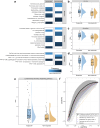Limited predictive value of the gut microbiome and metabolome for response to biological therapy in inflammatory bowel disease
- PMID: 39167702
- PMCID: PMC11340771
- DOI: 10.1080/19490976.2024.2391505
Limited predictive value of the gut microbiome and metabolome for response to biological therapy in inflammatory bowel disease
Abstract
Emerging evidence suggests the gut microbiome's potential in predicting response to biologic treatments in patients with inflammatory bowel disease (IBD). In this prospective study, we aimed to predict treatment response to vedolizumab and ustekinumab, integrating clinical data, gut microbiome profiles based on metagenomic sequencing, and untargeted fecal metabolomics. We aimed to identify predictive biomarkers and attempted to replicate microbiome-based signals from previous studies. We found that the predictive utility of the gut microbiome and fecal metabolites for treatment response was marginal compared to clinical features alone. Testing our identified microbial ratios in an external cohort reinforced the lack of predictive power of the microbiome. Additionally, we could not confirm previously published predictive signals observed in similar sized cohorts. Overall, these findings highlight the importance of external validation and larger sample sizes, to better understand the microbiome's impact on therapy outcomes in the setting of biologicals in IBD before potential clinical implementation.
Keywords: Inflammatory bowel disease; biologics; metabolomics; microbiome; prediction; ustekinumab; vedolizumab.
Conflict of interest statement
EAMF is supported by a ZonMW Clinical Fellowship grant (project number 90719075) and has received an unrestricted research grant from Takeda. RG received funding by Janssen Pharmaceuticals (for unrelated research projects) and received consulting funding from Esox Biologics (for unrelated research projects). RKW has received unrestricted Research Grants from Takeda, Johnson & Johnson, Ferring and Tramedico and speaker fees from Abbvie, MSD and Boston Scientific and has acted as a consultant for Takeda Pharmaceuticals.
Figures






References
-
- Schreiber S, Dignass A, Peyrin-Biroulet L, Hather G, Demuth D, Mosli M, Curtis R, Khalid JM, Loftus EV. Systematic review with meta-analysis: real-world effectiveness and safety of vedolizumab in patients with inflammatory bowel disease. J Gastroenterol. 2018;53(9):1048–1064. doi: 10.1007/s00535-018-1480-0. - DOI - PMC - PubMed
MeSH terms
Substances
LinkOut - more resources
Full Text Sources
Medical
